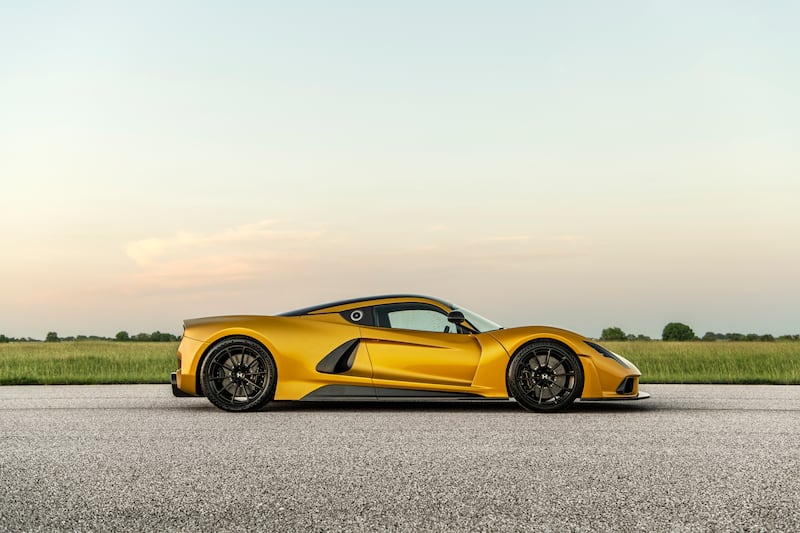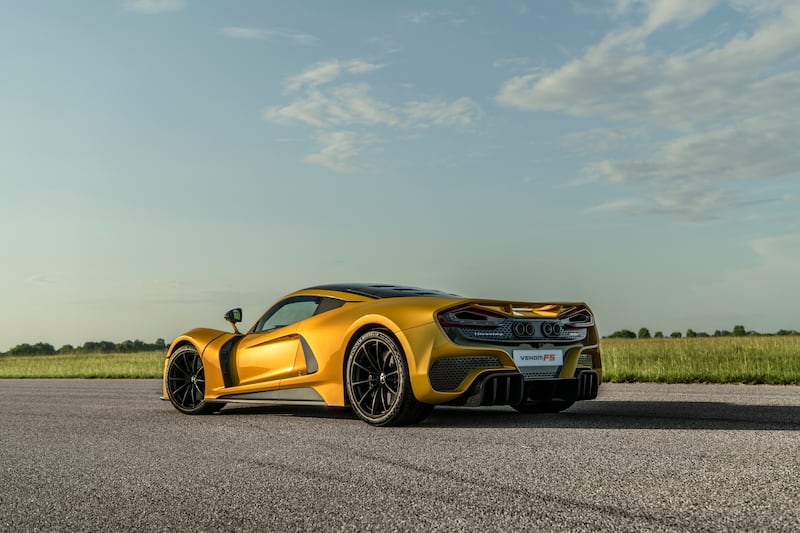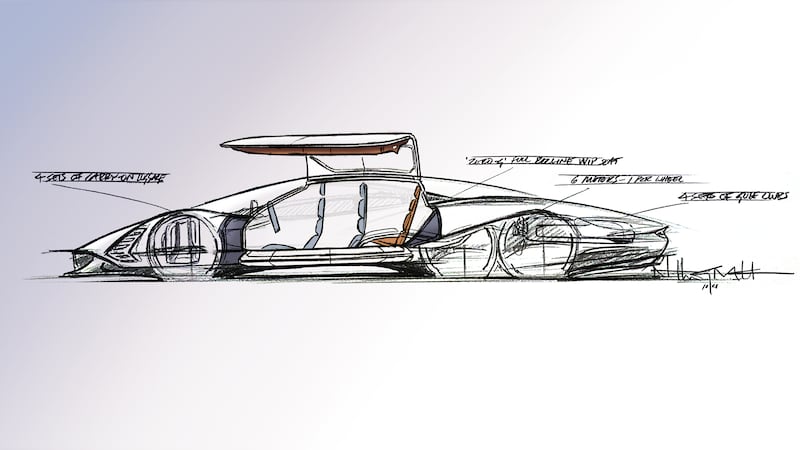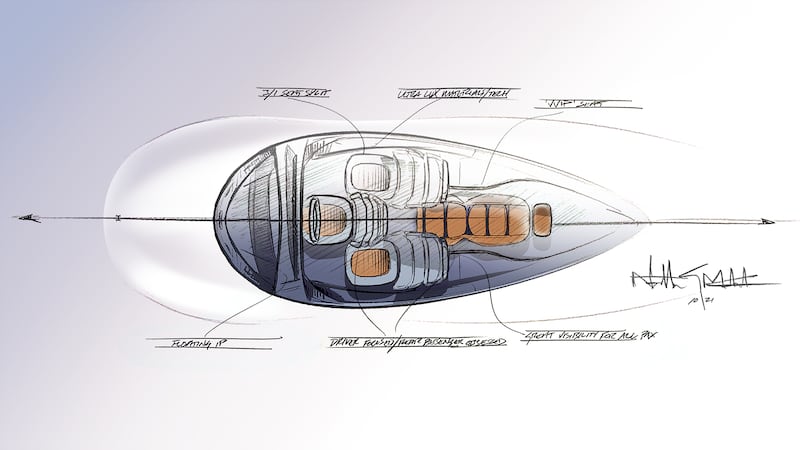As it rolls out of supercar alley at the Goodwood Festival of Speed, the Hennessey Venom F5 doesn’t look menacing; it looks malevolent. While it might be relatively quiet in its overall styling compared to the furthest reaches of excess that, say, Lamborghini goes to, the Venom F5 is unmistakably potent.
In style terms, it looks rather like a Ferrari that has piled on muscle and chugs protein shakes for breakfast, lunch, and dinner. That’s not a million miles from the truth, as the Venom is packing more power than any road-going Ferrari ever made. In fact, its 6.6-litre, twin-turbo V8 engine — designed and built by Hennessey — develops a faintly ridiculous 1,842hp and 1,617Nm of torque.
Hennessey is going to build 24 of these frankly unhinged devices, and another 30 with a removable targa roof panel. The Venom’s whole purpose in life is to set one record, and one record only — to become not just the fastest production car of all time, but to be the first to break through the 485km/h barrier, or a nice, round 300mp/h.

To give you an idea of just how potent the Hennessey Venom F5 is, Hennessey has been testing it at the runway once used by the space shuttle, adjacent to the Kennedy Space Centre in Florida. Even at 4.6km long, that runway isn’t long enough.
John Hennessey is the man behind all this madness. A Texan native with Cork ancestry, he has spent the last 30 years offering highly-tuned performance cars, built by a small but dedicated 50-strong team in Sealy, Texas. Hennessey started out offering performance-boosting kits for Ford Mustangs and V8-engined pickups, but his ambitions soon expanded. The first car badged as Venom GT was created in 2010, and based on a Lotus Exige. It soon vied for the title of world’s fastest, battling rivals from the likes of Bugatti and Koneigsegg, with a top speed of 435km/h.
The Venom F5 is Hennessey’s first all-in sports car, entirely designed and built by his eponymous company. And the space shuttle’s runway isn’t enough for it. “A runway is just not long enough for this car,” Hennessey tells The Irish Times when we sit down for a chat at Goodwood. “Even when we’ve tested on that Nasa runway, it’s just not long enough. We’re just never going to find the v-max of the car in that environment. So we’re currently working on securing a stretch of public highway in Texas, which we could close down for a short time, enough time to make the run. We think we need five, maybe six miles (9.6km) to hit v-max and bring the car safely down to a stop.”

Of course Hennessey isn’t alone in its ambitions to be the first to breach the 300mph barrier. Bugatti — newly combined with Croation electric car specialists Rimac, but still backed by the financial might of Volkswagen — has as big an ambition to be the first, as does Sweden’s Koengisegg, which like Hennessey is a company keen on causing upsets for larger, better-resourced firms.
Five minutes in Hennessey’s presence, though, and you’d be willing to bet the mortgage, the heating budget, and junior’s university savings on his Venom getting there first. Other companies try to shy away from the silliness of this particular contest, but Hennessey revels in it: “Of course giving the middle finger to the man, you know. Having contempt for authority and people in high places, that’s kind of how I grew up. And we still kind of roll that way. I’m Irish, so that’s kind of in the DNA,” Hennessey says, showing some of that rebel Cork determination. “Does Bugatti and VW have greater resources than we do? They might, but I don’t know if they’re as clever as we are. I think being a smaller company has helped us to think outside the box a little bit, and to do things differently. We’ll see what happens. At the same time, we get along very well with the guys from Koenigsegg, from Bugatti, from Ferrari. But yeah, it’d be fun to go out and go one notch higher than them.”
Thus far, Hennessey has resisted the lure of going motor racing as a shop window for his products. In fairness, he probably doesn’t need to — the Venom F5 is already sold out, even with its $2.1-million price tag (€2.02m) and the rest of the cars his company builds aren’t what you’d call natural racers anyway. Hennessey currently builds 15 different tuned cars, based on production models from Ford, Chevrolet, Dodge, Ram, Cadillac and Jeep. His headline new model is the VelociRaptor 600, a 560hp version of Ford’s V8-engined F150 Raptor pickup truck. Or, if pickups aren’t your thing, you could order a one-of-30 1,000hp Chevrolet Camaro, dubbed The Exorcist because Hennessey built it specifically to defeat the famous Dodge Demon on the drag strip.
Inevitably, given that we are sitting at the side of the Goodwood hillclimb, up which all manner of exotic racing machines are parading, the question of Hennessey going racing has to be raised — after all, it has dramatically raised the profile of his countryman and fellow sports car enthusiast Jim Glickenhaus, who has been taking on the might of Toyota at Le Mans. Hennessey isn’t so sure though: “I think when you look at Le Mans, and the Balance Of Power rules, there’s a lot of regulations, there’s a lot of politics,” he says. “That’s why I like going for v-max records. There are no rules, so that’s a place in which we’re more comfortable operating. But hey, to build a car to compete at Le Mans would be incredible. Look at what Carroll Shelby did all those years ago, so I would never say never to that opportunity, but right now we’re focused on building cars for our amazing clients.”
Hennessey is also focusing on an electric future, but he’s doing it in a way that likely no one else will attempt. In what is almost certainly a shot across Elon Musk’s bows, Hennessey is working on an all-electric hypercar called Deep Space. He may not be launching rockets into space, but Hennessey wants to put a rocket up the backside of the car industry, and set down a reputation marker for his company with this wild product.


The Deep Space is set to have six wheels, each with its own electric motor, and six-wheel drive. If all goes to plan, it will have 2,000hp, a $3 million price tag (€2.9-million), gull-wing doors, and seats for four with the driver sitting front and centre. There are two passenger seats to the left and right, with a fourth — designed as the “VVIP” seat — in the centre behind the driver, which can lie flat for a snooze on long journeys.
“Keeping Hennessey relevant in an electric age was one of the reasons I pushed for Deep Space to be our next car, not our third car down the line,” Hennessey says. “While I don’t think that, in my lifetime at any rate, the internal combustion engine is going to go away. I did want to put down a Hennessey stake in the electric world. We want to show the world, and the automotive world in particular, that we could do electrification very well, but in a very different way. We don’t just want to compete, we want to dominate. It’s really driven by what the customer wants. Ultimately, the old Steve Jobs saying is, the customer doesn’t always know what they want until you show it to them. So when we got an F5 client and we showed them the pictures of the Deep Space they’re like; ‘How soon can I get that?’ and suddenly, all their childhood dreams have come true. A picture says about a million words, right?”
Hennessey plans to have this wild creation on sale by 2026. If he can pull that off, while simultaneously pushing the Venom F5 beyond 300mph, then maybe Tesla won’t be seen as the only upstart automotive innovator any more.












